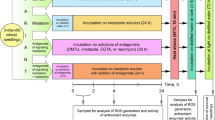Abstract
The effects of chilling stress on leaf photosynthesis and sucrose metabolism were investigated in tomato plants (Lycopersicon esculentum Mill. cultivar Marmande). Twenty-one-day-old seedlings were grown in a growth chamber at 25/23 °C (day/night) (control) and at 10/8 °C (day/night) (chilled) for 7 days. The most evident effect of chilling was the marked reduction of plant growth and of CO2 assimilation as measured after 7 days, the latter being associated with a decrease in stomatal closure and an increase in Ci. The inhibition in photosynthetic rate was also related to an impairment of photochemistry of photosystem II (PSII), as seen from the slight, but significant change in the ratio of Fv/Fm. The capacity of chilled leaves to maintain higher qP values with respect to the controls suggests that some protection mechanism prevented excess reduction of PSII acceptors. The results of the determination of starch and soluble sugar content could show that chilling impaired sucrose translocation. The activity of leaf invertase increased significantly in chilled plants, while that of other sucrose-metabolizing enzymes was not affected by growing temperature. Furthermore, the increase in invertase (neutral and acid) activity, which is typical of senescent tissue characterized by reduced growth, seems to confirm that tomato is a plant which is not a plant genetically adapted to low temperatures.
Similar content being viewed by others
References
Alberdi M., Corcuera L.J. 1991. Cold acclimation in plants. Phytochem., 30: 3177–3184.
Bruggemann W., van Kooij T.A.W., van Hasselt P.R. 1991. Long-term chilling of young tomato plants under low light and subsequent recovery. II. Growth, development and photosynthesis. Planta, 186: 172–178.
Bruggemann W., van Kooij T.A.W., van Hasselt P.R. 1992. Long-term chilling of young tomato plants under low light and subsequent recovery. II. Chlorophyll fluorescence, carbon metabolism and activity of ribulose-1,5-bisphosphate carboxylase/oxygenase. Planta, 186: 179–187.
Bjorkman O., Demmig B. 1987. Photon yield of O2 evolution and chlorophyll fluorescence characteristics at 77K among vascular plants of different origins. Planta, 170: 489–504.
Calderon P., Pontis H.G. 1985. Increase of sucrose synthase activity in wheat plants after a chilling shock. Plant Sci., 42: 173–176.
Demmig-Adams B., Adams W. W. III 1992. Photoprotection and other responses of plants to high light stress. Plant Physiol. Plant Molec. Biol., 43: 599–626.
Demmig-Adams B., Adams W. W. III 1996. The role of the xanthophyll cycle carotenoids in the protection of photosynthesis. Trends Plant Sci., 1: 21–26.
Ebrahim M.K., Zingsheim O., Shourbagy M.N., Moore P.H., Komor E. 1998. Growth in sugar storage in sugarcane grown at temperatures below and above optimum. J. Plant Physiol., 153: 593–602.
Fracheboud Y., Haldimann P., Leipner J., Stamp P. 1999. Chlorophyll fluorescence as a selection tool for cold tolerance of photosynthesis in maize (Zea mays L.). J. Exp. Bot., 50: 1533–1540.
Genty B., Briantais J.-M., Baker N.R. 1989. The relationship between the quantum yield of photosynthetic electron transport and quenching of chlorophyll fluorescence. Biochim. Biophys. Acta 990: 87–92.
Guidi L., Nali C., Ciompi S., Lorenzini G., Soldatini G.F. 1997. The use of chlorophyll fluorescence and leaf gas exchange as methods for studying the different responses to ozone of two bean cultivars. J. Exp. Bot., 48: 173–179.
Guy C.L., Huber J.L.A., Huber S.C. 1992. Sucrose phosphate synthase and sucrose accumulation at low temperature. Plant Physiol., 100: 502–508.
Huber S.C., Nielsen T.H., Huber J.L.A., Pharr D.M. 1989. Variation among species in light activation of sucrose-phosphate synthase. Plant, Cell Environm., 30: 277–285.
Janda T., Szalai G., Paldi E. 1996. Chlorophyll fluorescence and anthocyanin content in chilled maize plants after return to a non chilling temperature under various irradiance. Biologia Plantarum, 38: 625–627.
Jung S., Steffen K.L. 1997. Influence of photosynthetic photon flux densities before and during long-term chilling on xanthophyll cycle and chlorophyll fluorescence quenching in leaves of tomato (Lycopersicon hirsutum), Physiol. Plant., 100: 958–966.
Keller E., Steffen K.L. 1995. Increased chilling tolerance and altered carbon metabolism in tomato leaves following application of mechanical stress. Physiol. Plant., 93: 519–525.
Moran R. 1982. Formulae for determination of chlorophyllous pigments extracted with N,N-Dimethylformamide. Plant Physiol., 69: 1376–1381.
Ruban A.V., Horton P. 1995. Regulation of nonphotochemical quenching of chlorophyll fluorescence in plants. Aust. J. Plant Physiol., 22: 221–230.
Santoianni C.S., Tognetti J.A., Pontis H.G., Salerno G.L., 1993. Sucrose and fructans metabolism in wheat root at chilling temperature. Physiol. Plant., 87: 84–88.
Sassenrath G.F., Ort D.R. 1990. The relationship between inhibition of photosynthesis at low temperature and the inhibition of photosynthesis after rewarming in chill-sensitive tomato. Plant Physiol. Biochem., 28: 457–465.
Schreiber U, Bilger B and Neubauer C 1994. Chlorophyll fluorescence as a non-intrusive indicator for rapid assessment of in vivo photosynthesis. In: Ecophysiology of Photosynthesis. Ecological Studies, Vol. 100, ed. E.D. Schulze and M.M. Caldwell, Springer Verlag, Berlin (Germany): 49–70.
Szalai G., Janda T., Paldi E., Szigeti Z. 1996. Role of light in the development of post chilling symptoms in maize. J. Plant Physiol., 148: 378–383.
Van Kooten O., Snell J.H.F. 1990. The use of chlorophyll fluorescence nomenclature in plant stress physiology. Photosynth. Res., 25: 147–150.
Wang C.Y. 1990. Chilling injury of horticultural crops. CRC Press Inc., Boca Raton, Fla., USA.
Author information
Authors and Affiliations
Rights and permissions
About this article
Cite this article
Artuso, A., Guidi, L., Soldatini, G.F. et al. The influence of chilling on photosynthesis and activities of some enzymes of sucrose metabolism in Lycopersicon esculentum Mill. Acta Physiol Plant 22, 95–101 (2000). https://doi.org/10.1007/s11738-000-0062-x
Received:
Accepted:
Issue Date:
DOI: https://doi.org/10.1007/s11738-000-0062-x




